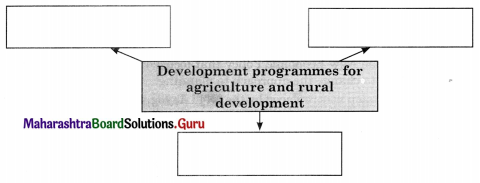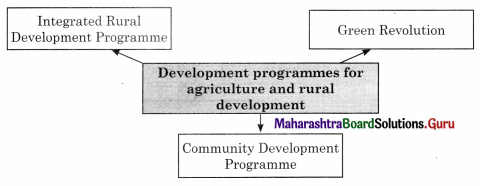Balbharti Maharashtra State Board Class 11 Political Science Important Questions Chapter 8 Development Administration Important Questions and Answers.
Maharashtra State Board 11th Political Science Important Questions Chapter 8 Development Administration
1A. Choose the appropriate alternative and complete the following statements.
Question 1.
Panchayati Raj institutions were given constitutional status in 1992 by the ____________ Amendment Act. (42nd, 73rd, 74th, 91st)
Answer:
73rd
Question 2.
To establish a socialist pattern of economy, ____________ year plans were introduced. (3, 5, 7, 10)
Answer:
5
![]()
Question 3.
To increase agricultural production, the ____________ revolution was introduced in 1966-67. (Rural, White, Green, Swachh Bharat)
Answer:
Green
Question 4.
MGNREGA aims to guarantee ‘the right to ____________’. (nutrition, education, irrigation, work)
Answer:
work
1B. State the appropriate concept for the given statement.
Question 1.
It has replaced the Planning Commission since 2015.
Answer:
NITI Aayog
Question 2.
A modern approach to Public Administration.
Answer:
Development Administration
![]()
1C. Answer in one sentence.
Question 1.
What does ‘red tape’ refer to?
Answer:
In government administration, when official rules and procedures create unnecessary delays in the work, it is called ‘red tape.
Question 2.
What does the ‘holistic perspective’ of development include?
Answer:
A holistic perspective of development includes a focus on social change, economic growth, cultural progress and political development.
Question 3.
Name two Parliamentary Committees.
Answer:
Public Accounts Committee, Estimates Committee.
Question 4.
Name 4 tribunals in the field of Indian administration.
Answer:
Income Tax Appellate Tribunal, Central Administrative Tribunal (CAT), National Green Tribunal (NGT), Securities Appellate Tribunal (SAT).
Question 5.
What was the focus of the Community Development Programme (1952)?
Answer:
The focus of CDP (1952) was to promote development in rural and remote areas.
Question 6.
What is the significance of the 74th Amendment Act (1952).
Answer:
The 74th Amendment Act gave constitutional status to the municipalities so that they function effectively as units of local government in urban areas.
![]()
Question 7.
Name 4 areas that five-year plans focused on.
Answer:
Agriculture, Industrialization, Self-reliance, Infrastructure.
Question 8.
What was the objective of the Twenty Point Programme?
Answer:
The objective of the Twenty Point Programme was poverty eradication and raising of the standard of living, of the people.
Question 9.
Write 2 development programmes to deal with unemployment.
Answer:
- Jawahar Rozgar Yojna (JRY – 1989)
- Mahatma Gandhi Nation Rural Employment Guarantee Act (MGNREGA – 2005)
Question 10.
What is the role of YASHADA?
Answer:
The role of YASHADA is as an Administrative Training Institute and a State Institute of Rural Development.
1D. Expand the abbreviations.
Question 1.
NITI Aayog
Answer:
NITI Aayog – National Institution for Transforming India.
Question 2.
IRDP
Answer:
IRDP – Integrated Rural Development Programme.
Question 3.
MGNREGA
Answer:
MGNREGA – Mahatma Gandhi National Rural Employment Guarantee Act.
Question 4.
UIDAI
Answer:
UIDAI – The Unique Identification Authority of India.
![]()
Question 5.
JNNURM
Answer:
JNNURM – Jawaharlal Nehru National Urban Renewal Mission.
2A. State whether the following statements are true or false with reasons.
Question 1.
Citizen participation is significant in development administration.
Answer:
This statement is True.
- Development is a process of social and economic change, it is important that people participate actively in it.
- This necessitates peoples’ participation in the process of planning, implementation, and eventual evaluation.
Question 2.
Land reforms were a major development goal in India after independence.
Answer:
This statement is True.
- When India became independent (zamindars). the ownership of agricultural land was mainly concentrated in the hands of a few landowners.
- To solve this issue land reforms were initiated and the land was freed up to be given to the actual tillers of the land e.g., the Zamindari system was abolished.
Question 3.
NITI Aayog replaced the Planning Commission in 2015.
Answer:
This statement is True.
- In the 1990s India adopted the New Economic Policy that focused on economic liberalisation. In this new setup, there was a need to change the approach to planning.
- In 2015 the Planning Commission was replaced by the NITI Aayog. India moved away from centralized planning to decentralized planning. The NITI Aayog proposes grassroots planning.
![]()
2B. Complete the concept maps.
Question 1.

Answer:

Question 2.

Answer:

4. Answer the following.
Question 1.
Explain how development administration evolved.
Answer:
After the Second World War, several Asian and African nations became independent. They did not want a government that merely carried out routine administration like law and order, external security, revenue, etc. These countries had heterogeneous societies, struggling economies and faced serious challenges like hunger, poverty, and socio-economic inequality. They needed to be planned and properly executed government action which would be holistic i.e., focusing on social change, political development, and economic growth.
The government had to become the instrument of development by taking up tasks like centralized economic planning, promotion of industrial growth, provision of social services, and encouraging people’s participation. The concept of the ‘Welfare State’ which had dominated the early part of the 20th century grows stronger. The state was expected to play a key role in the promotion of the economic and social well-being of its citizens. This led to the idea of the Development Administration.
![]()
Question 2.
Explain the features of development administration.
Answer:
Development Administration is the modern approach to public administration. Its features are-
(i) Change-oriented: Development administration seeks to re-orient towards development goals in the socio-economic and political sphere through transformation, innovation, and growth. In India after Independence, the two biggest challenges before the government were food scarcity and poverty, and economic backwardness. Hence, the focus was on agriculture as well as on industrial and infrastructural development.
(ii) Output-oriented: Development administration seeks to achieve certain outcomes on the basis of clear, quantitative norms of performance. This focus on targets motivates, the administration to produce the desired results, for e.g., pegging a target of 8 – 10% growth rate for the economy is a reasonable goal to be achieved.
(iii) Citizen participation: It is necessary that people actively participate in the development processes of planning, implementation and evaluation e.g., the 73rd and 74th amendments are a landmark in the evolution of grassroots democratic institutions both in rural and urban areas in India.
(iv) Public commitment: The process of development is filled with challenges and barriers. Hence, the civil servants (bureaucracy) need to have a strong sense of involvement, commitment, and concern to achieve the development objectives.
Question 3.
What were the goals of development in India post-1947?
Answer:
Post-independent India was struggling to rise from the ill effects of colonial exploitation i.e., from poverty and underdevelopment. The objectives of development in India were hence directed towards resolving these issues.
The goals of development include:
(i) Modernisation of the economy: The focus was on industrialization, which would increase employment facilities as well national income.
(ii) Land Reforms: aimed to free up land which was concentrated in the hands of a few rich landholders (zamindars).
(iii) Agriculture: The focus was to reduce rural poverty by developing agriculture. The use of machines, better fertilizers and pesticides, high yielding seeds, and irrigation would help to increase agricultural production i.e., through the Green Revolution.
(iv) Self-reliance: Although foreign aid was accepted by India for its industrial and infrastructural development, it did not want to be dependent on foreign capital for long.
![]()
(v) Socialist pattern of the economy: India decided to adopt the socialist pattern of the economy towards creating a Welfare State and reducing inequalities of wealth and income. The Planning Commission was created and 5-year plans were implemented.